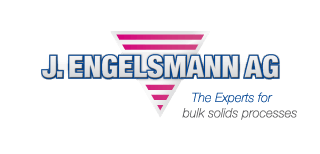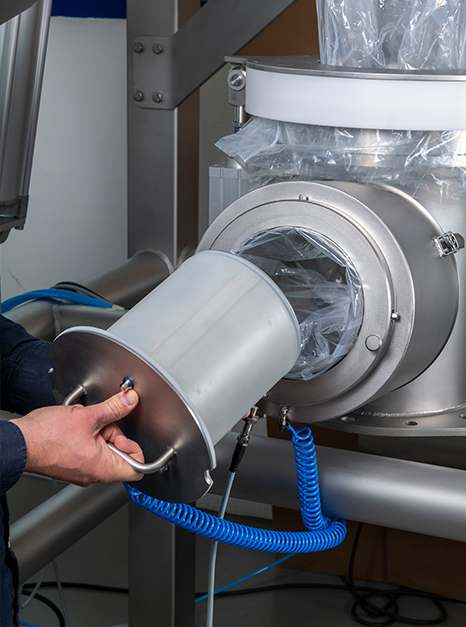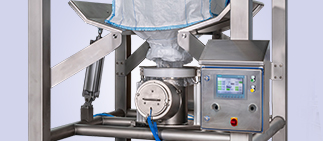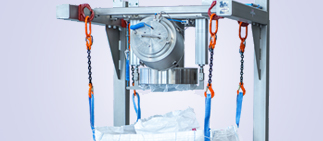Containment big bag handling
Containment systems are primarily used for safely handling harmful or highly active substances. Handling such substances in closed systems not only reduces the amount of substance particles that escape into the surrounding environment to an absolute minimum, but it also stops foreign substances from entering and contaminating the production process. By using containment systems, you can protect operating personnel and the product that is to be processed.
Handling big bags under containment conditions means particular challenges for facility operators. Here, the Containment must not only be kept constant during the filling and emptying process, but it is crucial that it is also maintained during the connection of a new big bag respectively during a container change. Operating errors, particularly at these critical interfaces, can cause leaks in the Containment and must therefore be avoided at all costs. Our containment solutions for big bag handling distinguish themselves by their high degree of automation and simply designed operating steps. These features help us to ensure that our big bag systems maintain a consistently high Containment level.
With the JEL SmartCon ES attachment system, big bags can be emptied under containment conditions up to OEB 4. The system is very easy and comfortable to operate.
» Further information
With the JEL SmartCon BS attachment system, big bags can be filled under containment conditions up to OEB 4. Thanks to the high degree of automation, the filling can be done safely and in just a few simple steps.
» Further information
Containment is defined as “the act of keeping something under control so that it cannot spread in a harmful way”. And this is exactly what containment systems should guarantee. The product being processed should not be able to escape from the production process to the outside environment (personal protection), nor should it be able to be contaminated by a foreign substance (product protection, protection against cross contamination). There are many different approaches to achieving a certain containment level with big bag systems. Something that all containment systems have in common is their extremely high level of leak-tightness which must be ensured with the operation of the equipment and with interfaces to other processes.
Containment measures can be split into two categories: primary and secondary containment. All measures that should prevent a substance from escaping from the production equipment or stop a substance from outside entering the equipment fall under primary containment. Secondary containment covers all other protective measures that come into play when the primary containment is not sufficient. For example, a big bag emptying system that can be used up to a certain containment level falls under the category of primary containment. The use of clean rooms or air locks for personnel is an example of a secondary containment measure.
Product and personnel protection has always been an issue in the pharmaceutical industry and it is becoming increasingly important nowadays. The reason for this is the increasing concentration of active pharmaceutical ingredients in products. One in every four active ingredients that is developed today is a highly potent API. The operating personnel should come into contact with these highly active substances as little as possible. Along with personal protection, product protection and protection against cross contamination play a big role. In order to guarantee the quality and efficacy of highly active substances, it must be ensured that even the smallest product quantities do not get mixed with each other during production.
In the chemical industry, it is first and foremost the REACH regulation (EC 1907/2006) that prompts operators to introduce containment systems for big bag handling. REACH prescribes the registration of all chemical substances that are manufactured or imported in quantities of 1 t/a or more. For all registered substances where a quantity of over 10 t/a has been produced, a technical dossier and safety report which cover the potential risks and exposition scenarios must also be compiled by the manufacturer. Harmful substances should be substituted for another substance where possible. If this is not possible, operators must prove that they can work safely with this harmful substance and that they have taken appropriate risk management measures. One of the most common types of measures taken is the use of containment solutions.
Containment systems for big bag systems are also used in the foodstuffs industry. Closed containment systems protect foods suitable for allergy sufferers from cross contamination with products from different production lines. Even members of personnel often need to be protected against allergens or finely powdered products.
In principal, containment systems for big bag handling can be used in all industries where substances are filled or emptied, where operating personnel should be in contact with the product as little as possible or where products need to be protected against impurities from other product residues.
Not all substances are equally harmful or toxic. Two main limit values are used to classify the containment requirements:
OEL (Occupational Exposure Limit): This value describes the average concentration of a substance in the air that the operating personnel can be exposed to for a defined period of time without experiencing any adverse health effects. The period of measurement is eight hours or one workday.
OEB (Occupational Exposure Band): This value classifies the toxicity of a substance on a scale from 1 to 6. The more harmful the substance, the higher the OEB value.
OEL and OEB go hand in hand as the Operator Exposure Limit can be used to allocate the corresponding Operator Exposure Band and vice versa. For example, OEB 5 is equivalent to an exposure of less than 1 μg/m³ - which is one millionth of a gram. Usually, manufacturers of containment systems get professional measurements taken (e.g. according to SMEPAC) to determine which limit values the big bag station can be used for. Thanks to the classification, manufacturers can group their containment systems and operators can choose the suitable equipment for themselves. Here, care must be taken to ensure that the big bag station or system used meets the containment requirements but also that it does not exceed them, as generally the higher the required containment level, the more complex and does not exceed them, as generally the higher the required containment level, the more complex and expensive the required equipment is. An overqualified system is therefore not economically efficient.
The containment pyramid illustrates the OEL and OEB classifications:
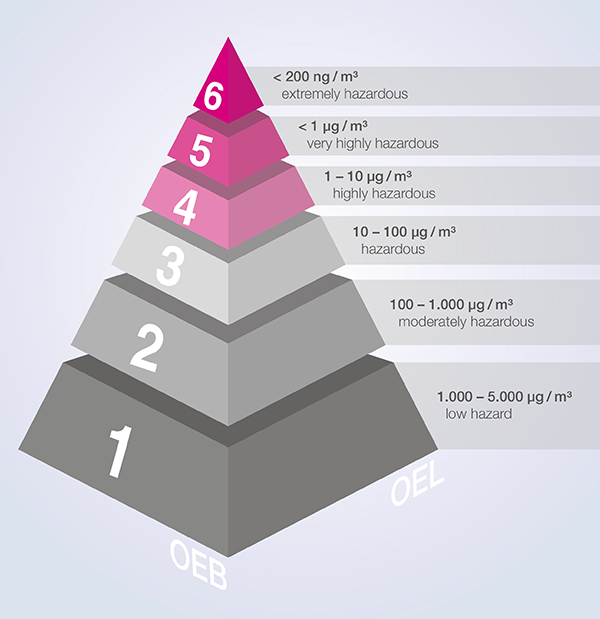
For a long time, many people understood containment primarily as working in protective suits. However, this approach has a major downside: full body suits do indeed protect the operator but they do not protect the product. In addition, it is not reasonable to expect personnel to work in full protective gear for an extended amount of time. The better solution is to use machines and systems that have been specially designed for use under containment conditions and that provide adequate protection for both the product and the operating personnel.
Containment components are built in such a way that no or barely any substance particles can escape into the environment surrounding the machine nor can any substance particles enter the production process from outside. With regard to the secondary containment, this can be achieved through the use of glove boxes or air locks, for example. Components of the primary containment often feature special sealing systems or endless liner systems as part of a constructive solution. Something all of these examples have in common is an extremely high level of leak-tightness which must be guaranteed at interfaces and material transfer points in particular. A further critical point when it comes to maintaining a constantly high containment level is the operating personnel. When manual operating steps come into play, the risk of operating errors which can lead to a break in the containment increases. With big bag systems for containment applications it is therefore sensible to design critical process steps like connecting and disconnecting a big bag so that they are as simple as possible or even automating them if possible.

